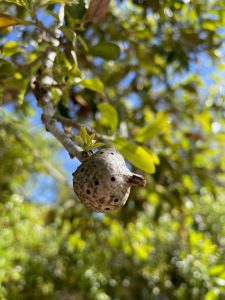
It’s an occupational hazard—because I am always teaching people about trees, I find myself subconsciously identifying plants as I am walking, biking, or driving down the road. It’s a compulsion borne of decades of needing to be ready to answer a question about what this or that species is. If you have ever done any tree identification, you know that leaves are usually the most easily differentiated part of any given tree. Of course, some species have showy flowers, interesting seeds, or a unique bark or shape—but leaves often tell the story most clearly.

So, in my daily practice of staring into the branches, I will typically notice when things are out of sorts. Leaf galls are among the most common and interesting reasons a leaf can be misshapen. While galls can form on many species of plants, typically (60% of the time) they are found on oak trees and created by gall wasps that have laid eggs into the plant tissue. Much like human skin reacts to a splinter or insect bite by swelling around it, plant cells respond to this foreign tissue by growing a gall around the expanding egg sac to protect the plant. Insect larvae eventually feed on the gall tissue until they’ve reached adulthood. Many galls have small pinholes, a sign that the adult insect has emerged, and the gall is empty. Each gall-laying insect has its own characteristic shape. Typically, the insects move in and out of plant tissue without causing any significant damage to the overall plant. So, management of insects is rarely necessary.

Dozens of different insects lay eggs and form galls on a variety of plant species. While the oak leaf gall is quite typical in our area, another commonly seen gall is that of the swamp bay (Persea palustris). I have never seen a swamp bay tree without many green, oblong galls wrapped into the curled leaves. This gall is formed by the red bay psyllid, a harmless moth-type insect. While strange looking, galls rarely cause problems for the swamp bays and are an example of commensalism, a relationship in which one organism benefits while the other is neither harmed nor helped. The word “gall” means “bitter,” a reference to the taste of these tannin-filled growths.
 3
3
